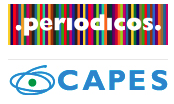Estrategias para lograr objetivos afectivos en la educación remota
DOI:
https://doi.org/10.35699/2237-5864.2020.24493Palabras clave:
Objetivos afectivos, Enseñanza remota, Enseñanza híbrida, Pandemia, Covid-19Resumen
El trabajo aquí presentado fue motivado por la amplia utilización de la videoconferencia como alternativa a las clases presenciales debido a la pandemia provocada por Covid-19. Se puede caracterizar como un ensayo teórico que tiene como propuesta discutir la efectividad de la educación remota para lograr objetivos afectivos de aprendizaje. Los objetivos más fáciles de conseguir a través de clases expositivas y, en consecuencia, a través de videoconferencias, son los cognitivos, sobre todo en los niveles de memorización y comprensión. Cuando los objetivos de aprendizaje están en el dominio afectivo, que involucran emociones, sentimientos y actitudes, se requieren otras estrategias. Así, a partir del aporte de los teóricos en el campo de los objetivos de aprendizaje y de los resultados de investigaciones empíricas, se discuten las posibilidades de utilización de distintas estrategias en plataformas de cursos en línea. Se debaten las estrategias de discusión reflexiva, trabajo colaborativo, grupo de verbalización/grupo de observación, tutoría entre pares, dramatización, simposio, seminario y gamificación. El estudio apunta a la adopción de la educación híbrida como la forma preferencial de educación superior en el escenario pospandémico, pero que debe estar acompañada de la formación de los docentes en el uso de estrategias de enseñanza grupal.
Descargas
Citas
AKOS, Patrick; KRETCHMAR, Jen. Investigating grit at a non-cognitive predictor of college success. The Review of Higher Education, Baltimore, v. 40, n. 2, p. 163-186, 2017. Disponível em: https://muse.jhu.edu/article/640608. Acesso em: 06 ago. 2020. DOI: https://doi.org/10.1353/rhe.2017.0000.
ANDERSON, Lorin W. et al. A taxonomy for learning, teaching, and assessing: A revision of Bloom's taxonomy of educational objectives. Essex: Longman, 2001.
BAKER, Ryan Shaun J. D. et al. Better to be frustrated than bored: The incidence, persistence, and impact of learners’ cognitive–affective states during interactions with three different computer-based learning environments. International Journal of Human-Computer Studies, Amsterdã, v. 68, n. 4, p. 223-241, 2010. Disponível em: https://www.sciencedirect.com/science/article/abs/pii/S1071581909001797. Acesso em: 06 ago. 2020. DOI: https://doi.org/10.1016/j.ijhcs.2009.12.003.
BERGMANN, Jonathan. Sala de aula invertida. São Paulo: Grupo Gen-LTC, 2016.
BIRBECK, David. Graduate qualities and the affective domain: New horizons to explore. 2009. Tese (Doutorado em Educação) – Learning and Teaching Unit, University of South Australia, Adelaide, 2009.
BLOOM, Benjamin Samuel et al. Taxonomy of educational objectives: the classification of educational goals: handbook I: cognitive domain. Nova Iorque: D. Mckay, 1956.
BOBBITT, John Franklin. How to Make a Curriculum. Boston: Houghton Mifflin, 1924.
BOLIN, Aaron U.; KHRAMTSOVA, Irina; SAARNIO, David. Using student journals to stimulate authentic learning: balancing Bloom's cognitive and affective domains. Teaching of Psychology, Oxfordshire, v. 32, n. 3, p. 154-159, 2005. Disponível em: https://www.tandfonline.com/doi/abs/10.1207/s15328023top3203_3. Acesso em: 06 ago. 2020. DOI: https://doi.org/10.1207/s15328023top3203_3.
CATE, Olle Ten; DE HAES, Hanekke (JCJM). Summative assessment of medical students in the affective domain. Medical Teacher, [S.l], v. 22, n. 1, p. 40-43, 2000. DOI: https://doi.org/10.1080/01421590078805.
CLEVELAND-INNES, Martha; ALLY, Mohamed. Learning to feel: Education, affective outcomes and the use of online teaching and learning. European Journal of Open, Distance and E-learning, Berlim, v. 10, n. 2, p. 1-17, 2007. Disponível em: https://www.eurodl.org/?p=archives&year=2007&halfyear=2&..&abstract=285. Acesso em: 06 ago. 2020.
D'MELLO, Sidney; GRAESSER, Art. Dynamics of affective states during complex learning. Learning and Instruction, Amsterdã, v. 22, n. 2, 145-157, 2012. Disponível em: https://www.sciencedirect.com/science/article/abs/pii/S0959475211000806. Acesso em: 29 set. 2020. DOI: https://doi.org/10.1016/j.learninstruc.2011.10.001.
DU BOULAY, Bento. Projetando interação educacional afetiva e cognitiva. In: LUCKIN, Rosemary et al. Handbook of Design in Educational Technology. Nova Iorque: Routledge, 2013. p. 168-175. Disponível em: encurtador.com.br/Fagms. Acesso em: 06 ago. 2020.
ECCLESTONE, Kathryn; HAYES, Dennis. Afetar: conhecimento, comunicação, criatividade e emoção. 2008. Disponível em: https://www.researchgate.net/publication/265454681_The_Dangerous_Rise_of_Therapeutic_Education. Acesso em: 06 ago 2020. DOI: https://doi.org/10.4324/9780203870563.
FALOUT, Joseph; ELWOOD, James; HOOD, Michael. Demotivation: Affective states and learning outcomes. System, Amsterdã, v. 37, n. 3, p. 403-417, 2009. Disponível em: https://www.sciencedirect.com/science/article/abs/pii/S0346251X09000566. Acesso em: 06 ago 2020. DOI: https://doi.org/10.1016/j.system.2009.03.004.
FASSO, Wendy; KNIGHT, Bruce Allen. Afetam no aprendizado on-line: resultados, emoções e estados afetivos. In: Aplicações Inovadoras de Pedagogia Online e Design de Cursos. Hershey: IGI Global, 2018. p. 128-153.
GIL, Antonio Carlos. Metodologia do ensino superior. São Paulo: Atlas, 2020.
GREENWOOD, Charles R.; CARTA, Judith J.; HALL, R. Vancel. The Use of Peer Tutoring Strategies in Classroom Management and Educational Instruction, School Psychology Review, Londres, v. 17, n. 2, 258-275, 1988. DOI: https://doi.org/10.1080/02796015.1988.12085342.
GRIFFIN, Lynda; ROY, James. A great resource that should be utilised more, but also a place of anxiety: student perspectives on using an online discussion forum. Open Learning: The Journal of Open, Distance and e-Learning, Londres, p. 1-16, 2019. DOI: https://doi.org/10.1080/02680513.2019.1644159.
GRONLUND, Norman E. How to write and use instructional objectives. Englewood Cliffs: Merrill/Prentice-Hall, 1995.
HOMER, Bruce D.; PLASS, Jan L.; BLAKE, Linda. The effects of video on cognitive load and social presence in multimedia-learning. Computers in Human Behavior, Amsterdã, v. 24, n. 3, 786-797, 2008. Disponível em: https://www.sciencedirect.com/science/article/abs/pii/S0747563207000544. Acesso em: 29 set. 2020. DOI: https://doi.org/10.1016/j.chb.2007.02.009.
HORN, Michael B.; STAKER, Heather. Blended: usando a inovação disruptiva para aprimorar a educação. Porto Alegre: Penso, 2015.
JAGGER, Suzy. Affective learning and the classroom debate. Innovations in Education and Teaching International, Londres, v. 50, n. 1, p. 38-50, 2013. Disponível em: https://srhe.tandfonline.com/doi/abs/10.1080/14703297.2012.746515. Acesso em: 06 ago. 2020. DOI: https://doi.org/10.1080/14703297.2012.746515.
JOHNSON, David W.; JOHNSON, Roger T. Fazendo funcionar a aprendizagem cooperativa. Teoria em prática, [S.l.], v. 38, n. 2, p. 67-73, 1999.
KRATHWOHL, David R.; BLOOM, Benjamin S.; MASIA, Bertram B. Taxonomy of educational objectives, handbook ii: affective domain. Nova Iorque: David McKay Company, 1964.
LEE, Cheng-Yuan. Student motivation in the online learning environment. Journal of Educational Media & Library Sciences, Taiwan, v. 37, n. 4, p. 367-375, 2000. Disponível em: http://joemls.dils.tku.edu.tw/fulltext/37/37-4/367-375.pdf. Acesso em: 06 ago. 2020.
LYNCH, Sandra; HART, Bethne; COSTA, Catherine M. Giving voice to values: An undergraduate nursing curriculum project. Collegian, Palo Alto, v. 21, n. 4, p. 367-373, 2014. Disponível em: https://www.sciencedirect.com/science/article/abs/pii/S1322769613000929. Acesso em: 06 ago. 2020. DOI: https://doi.org/10.1016/j.colegn.2013.09.004.
MAGER, Robert F. Preparing instructional objectives. Palo Alto: Fearon Publishers, 1962. Disponível em: https://eric.ed.gov/?id=ED018143. Acesso em: 29 set. 2020.
MAJURI, Jenni; KOIVISTO, Jonna; HAMARI, Juho. Gamification of education and learning: A review of empirical literature. In: GAMIFIN 2018, 2., 2018. Pori. Proceedings of the 2nd international GamiFIN conference. Pori: CEUR-WS, 2018. p. 11-19. Disponível em: https://trepo.tuni.fi/bitstream/handle/10024/104598/gamification_of_education_2018.pdf. Acesso em: 29 set. 2020.
MARTIN, Barbara L.; BRIGGS, Leslie J. The affective and cognitive domains: Integration for instruction and research. Nova Jérsei, Educational Technology, 1986. Disponível em: encurtador.com.br/jtFIU. Acesso em: 06 ago. 2020.
MARTIN, Florence; PARKER, Michele A. Use of synchronous virtual classrooms: Why, who, and how. MERLOT Journal of Online Learning and Teaching, Long Beach, v. 10, n. 2, p. 192-210, 2014.
MOORE, Schuster M. Theory of transactional distance. In: KEEGAN, Desmond. (ed.), Theoretical principles of distance education. Nova Iorque: Routledge, 1997. p. 22-38.
MOORE, Michael G.; KEARSLEY, Gres. Educação a distância: sistemas de aprendizagem on-line. São Paulo: Cengage Learning, 2013.
MORENO, Jacob Levy. Fundamentos do psicodrama. São Paulo: Summus, 1983.
NORTHEY, Gavin et al. Increasing student engagement using asynchronous learning. Journal of Marketing Education, Londres, v. 37, n. 3, p. 171-180, 2015. DOI: https://doi.org/10.1177/0273475315589814.
OLATUNJI, Michael Olalekan. Online Education: Issues, Challenges and Implications. Khazar Journal of Humanities & Social Sciences, Baku, v. 16, n. 3, 2013. Disponível em: https://jhss-khazar.org/wp-content/uploads/2010/04/0005KHAZAR_Journal_of_Humanities_and_Social_Sci_ences1.pdf. Acesso em: 06 ago. 2020.
SEELS, Barbara; GLASGOW, Zita. Exercises in instructional design. Columbus: Merrill Publishing Company, 1990.
SHOFFNER, Melanie. The place of the personal: Exploring the affective domain through reflection in teacher preparation. Teaching and Teacher Education, Amsterdã, v. 25, n. 6, p. 783-789, 2009. Disponível em: https://www.sciencedirect.com/science/article/abs/pii/S0742051X08002011. Acesso em: 06 ago 2020. DOI: https://doi.org/10.1016/j.tate.2008.11.012.
SHORT, John; WILLIAMS, Ederyn; CHRISTIE, Bruce. The social psychology of telecommunications. [S.l.]: John Wiley & Sons, 1976.
SNELSON, Chareen; ELISON-BOWERS, Patt R. Using YouTube videos to engage the affective domain in e-learning. In: MENDEZ-VILAS; Antonio et al. Research, Reflections and Innovations in Integrating ICT in Education. Badajoz: Formatex, 2009. p. 1481-1485. Disponível em: https://scholarworks.boisestate.edu/edtech_facpubs/50/. Acesso em: 06 ago. 2020.
TYLER, Ralph W. Basic principles of curriculum and instruction. Chicago: University of Chicago Press, 1949.
VAN DER HOEVEN KRAFT, Katrien J. et al. Engaging students to learn through the affective domain: A new framework for teaching in the geosciences. Journal of Geoscience Education, Northfield, v. 59, n. 2, p. 71-84, 2011. Disponível em: https://www.tandfonline.com/doi/abs/10.5408/1.3543934a. Acesso em: 06 ago. 2020. DOI: https://doi.org/10.5408/1.3543934a.
WHITE, Karl R. T-groups revisited: Self-concept change and the "Fish-Bowling" technique. Small Group Behavior, Pensilvânia, v. 5, n. 4, p. 473-485, 1974. DOI: https://doi.org/10.1177/104649647400500407.

Descargas
Publicado
Cómo citar
Número
Sección
Licencia
Derechos de autor 2020 Antonio Carlos Gil, Arquimedes Pessoni

Esta obra está bajo una licencia internacional Creative Commons Atribución 4.0.
Los autores que publican en esta revista conservan los derechos de autor y otorgan a la revista el derecho de primera publicación, siendo la obra licenciada simultáneamente bajo la Creative Commons Attribution License, que permite compartir la obra con reconocimiento de autoría y publicación inicial en esta revista.
Los autores están autorizados a asumir contratos adicionales por separado, para la distribución no exclusiva de la versión del trabajo publicado en esta revista (por ejemplo, publicación en un repositorio institucional o como capítulo de libro), con reconocimiento de autoría y publicación inicial en esta revista.
Política de acceso abierto:
La Revista Docência do Ensino Superior es una revista de Acceso Abierto, lo que significa que todo el contenido está disponible de forma gratuita, sin costo para el usuario o su institución. Los usuarios pueden leer, descargar, copiar, distribuir, imprimir, buscar o vincular a los textos completos de los artículos, o utilizarlos para cualquier otro propósito legal, sin necesidad de obtener el permiso previo del editor o autor, siempre que respeten la licencia de uso. los Creative Commons utilizados por la revista. Esta definición de acceso abierto está en línea con la Iniciativa de Acceso Abierto de Budapest (BOAI).























